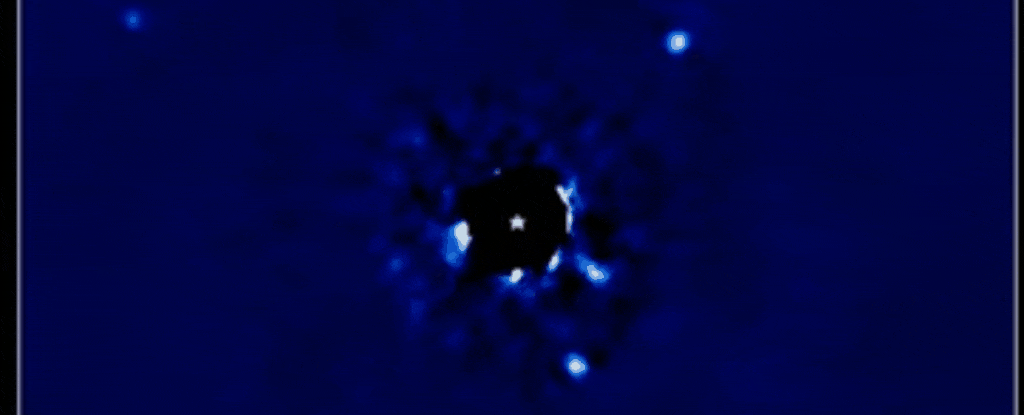A new video shared on YouTube is one of the most amazing things we've ever seen in planetary science.
The video shows four dots of light moving in partial concentric circles around a black disk at their center. What you're actually looking at is a planetary system.
The four dots are exoplanets, with the black disk obscuring their star, 133.3 light-years away from Earth. The partial circles are their orbital motions, a time-lapse compiled from 12 years of observations.
The star is HR8799, and in 2008 its exoplanets made up the first system (not the first exoplanet, that was 2M1207b in 2004) astronomers had ever seen directly.
Since then, astronomer Jason Wang of Northwestern University has been watching it avidly. He's compiled those observations into a time-lapse – not for any scientific reason, but just because it's super awesome.
"It's usually difficult to see planets in orbit," Wang says.
"For example, it isn't apparent that Jupiter or Mars orbit our sun because we live in the same system and don't have a top-down view. Astronomical events either happen too quickly or too slowly to capture in a movie.
"But this video shows planets moving on a human time scale. I hope it enables people to enjoy something wondrous."
The current count of confirmed exoplanets – that's extrasolar planets, or planets outside the Solar System – numbers over 5,200, but we've never actually seen most of them.
Astronomers primarily find exoplanets through indirect methods, by studying the effect the exoplanet has on the host star. Regular, faint dips in the star's light indicate an orbiting exoplanet passing between us and the star; faint changes in the wavelength of the star's light indicate the gravitational interaction between exoplanet and star.
The reason for this is that it's actually extremely difficult to see an exoplanet directly. They're very small, and very dim in comparison to their host star; any light they emit or reflect is usually swallowed up in the blazing light of the star.
Every now and again, however, we get lucky. The exoplanets are large and separated from their star enough, and the system oriented in such a way that, if the star's light is blocked, or occulted (that's why HR8799 appears as a black disk), we can see them as small blobs of attendant light.
Even rarer is to see them performing their complex planetary pavane, simply because the timescales of the orbits involved are much longer than the time since scientists directly spotted the first exoplanet.
But Wang and his team now have enough observational data of HR8799 for a time-lapse that shows partial orbits, and that is what he has compiled.
"There's nothing to be gained scientifically from watching the orbiting systems in a time lapse video, but it helps others appreciate what we're studying," Wang says.
"It can be difficult to explain the nuances of science with words. But showing science in action helps others understand its importance."

The observations were collected using the W. M. Keck Observatory, and Wang applied adaptive optics to correct for the distorting effect of Earth's atmosphere.
The time-lapse has also been processed to correct for the temporal jumps between data, showing the smooth orbital motion of the four exoplanets.
The 12 years of observation have been sped up into just 4.5 seconds.
Here's what you're looking at. The black circle in the center is the young 30-million-year-old star, around 1.5 times the mass and 4.9 times the brightness of the Sun.
The innermost exoplanet is HR8799e, with a mass of 7.4 Jupiters orbiting at a distance of 16.25 times the separation between Earth and the Sun, or astronomical units, for an orbital period of 45 years. Scientists have been able to analyze the light from this exoplanet to determine that it's a storm-wracked baby gas giant.
Moving outwards, HR8799d has the mass of 9.1 Jupiters, and orbits at 26.67 astronomical units for an orbital period of 100 years.
HR8799c is 7.8 Jupiters in mass, orbiting at a distance of 41.4 astronomical units (just a little wider than the separation between the Sun and Pluto) for an orbital period of 190 years. It has water in its atmosphere, scientists have found.
Finally, HR8799b clocks in at 5.7 Jupiters, with a separation of 71.6 astronomical units and an orbital period of 460 years.
But we're a long way from being done with the HR8799 system.
Although, according to Wang, the time-lapse itself may not be scientifically revealing, the Keck data collection sure is.
A paper published in December last year found the possible existence of a fifth exoplanet, smaller and closer to the star than its siblings. The candidate is estimated to be around 4 to 7 times the mass of Jupiter, orbiting at a distance between 4 and 5 astronomical units, making it harder to spot directly.
And Wang and his colleagues are hard at work analyzing the light from the system. They hope that they will be able to obtain detailed information on the composition of not just the star, but the worlds around it.
"In astrophysics, most of the time we are doing data analysis or testing hypotheses," Wang says.
"But this is the fun part of science. It inspires awe."
